
Guilherme Menegon Arantes is Associate Professor at the Department of Biochemistry at the University of São Paulo (USP) and, along with other fellow researchers, he wrote the article “Tunneling and Nonadiabatic Effects on a Proton-Coupled Electron Transfer Model for the Qo Site in Cytochrome bc1”, published in the Journal of Chemical Information and Modeling, in 2021.
Abstract: Cytochrome bc1 is a fundamental enzyme for cellular respiration and photosynthesis. This dimeric protein complex catalyzes a proton-coupled electron transfer (PCET) from the reduced coenzyme-Q substrate (Q) to a bimetallic iron–sulfur cluster in the Qo active site. Herein, we combine molecular dynamics simulations of the complete cytochrome bc1 protein with electronic-structure calculations of truncated models and a semiclassical tunneling theory to investigate the electron–proton adiabaticity of the initial reaction catalyzed in the Qo site. After sampling possible orientations between the Q substrate and a histidine side chain that functions as hydrogen acceptor, we find that a truncated model composed by ubiquinol-methyl and imidazole-iron(III)-sulfide captures the expected changes in oxidation and spin states of the electron donor and acceptor. Diabatic electronic surfaces obtained for this model with multiconfigurational wave function calculations demonstrate that this reaction is electronic nonadiabatic, and proton tunneling is faster than mixing of electronic configurations. These results indicate the formalism that should be used to calculate vibronic couplings and kinetic parameters for the initial reaction in the Qo site of cytochrome bc1. This framework for molecular simulation may also be applied to investigate other PCET reactions in the Q-cycle or in various metalloproteins that catalyze proton translocation coupled to redox processes.
Authors: Sofia R. G. Camilo, Felipe Curtolo, Vanesa V. Galassi, and Guilherme M. Arantes.
Share